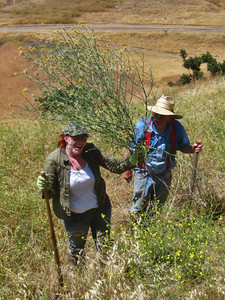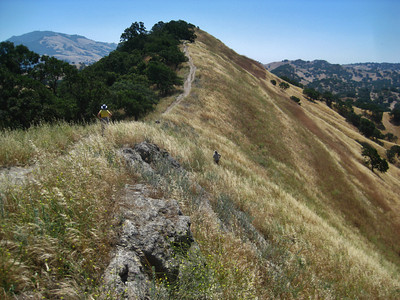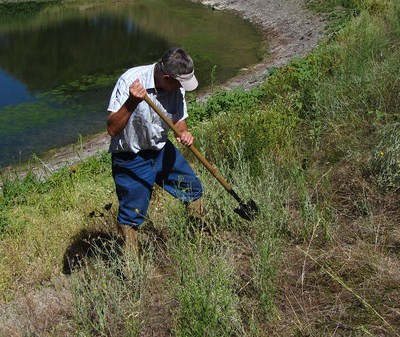Shell Ridge Weed Eradication
Many exotic (non-native) weeds inhabit our Open Space, and more appear each year. While many of our goals entail revegetation projects, we are dedicated to keeping what we do have relatively free of various noxious weeds.
Board members Katrina Nagle and Barney Howard removing a large YST plant
Yellow Starthistle
One of the potentially most destructive weeds is Centaurea solstitialis, or yellow starthistle (YST). Apart from being a major trailside nuisance to hikers, dogs and cyclists (and potentially deadly to horses), YST severely impacts the ecology of the open space where it becomes established. Joe DiTomaso, a Faculty member at UC Davis and statewide expert on Centaurea solstitialis, reports that YST is able to outcompete young seedling oaks and native grasses such as Stipa pulchra because of its long tap root and habit of growing through-out the summer and into the fall (Yellow Starthistle Management Guide, pg. 9-10). He also notes (pg. 12) that European honey bees will prefer YST over natives (i.e. Grindelia camporum, our local native Grindelia) while the native bees, what few remain, prefer Grindelia to YST. Ironically, such European bee preferences contribute to highly successful pollination and seed production of YST to the detriment of such natives as Grindelia. He describes this as ”...honeybees and yellow star may act as invasive mutualists, increasing the survivorship of each other.”The spread of European and Eurasian weeds into California has gone through several stages since these plants were first brought to California in 1851. While YST has been in California for a number of years, and actually declined in the 1920s and 1930s, it has rapidly increased its acreage since the 1960s.

Shell Ridge Summit Trail showing the area where the Foundation has concentrated its YST removal efforts
Shell Ridge Summit
In the past 15 years members of the Foundation have tackled and eliminated YST in Shell Ridge, particularly in the large quarry, along the Briones to Mt. Diablo Regional Trail, and the west section of the Fossil Hill Loop Trail. In 2010, an expanding population of YST was noted on the summit of Shell Ridge and efforts were begun to control it. There was a concern that it could spread downhill into the large central valleys of the Open Space, so a small group of volunteers from the neighborhood bordering the Marshall Drive entrance to the Open Space began an effort to eradicate YST. By the fall of 2012, we had, through a combination of mechanical weeding, limited chemical application, and huge amounts of good old fashioned hand work from February to October, mostly eradicated YST from approximately 15 acres of the Ridge. We have found that if no seed is produced for 2 years in a row, 99% of the previous population is eliminated. In addition, several other infestations were identified by local volunteers and have been worked on steadily for the last several years.
Project leader Phil Johnson removing YST from the Twin Ponds area




 Join
Join Donate
Donate Volunteer
Volunteer Maps
Maps Newsletter
Newsletter Facebook
Facebook
